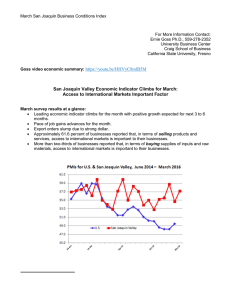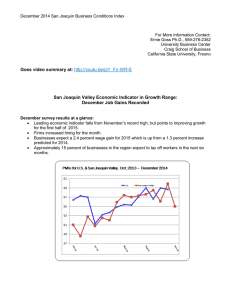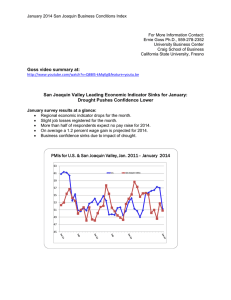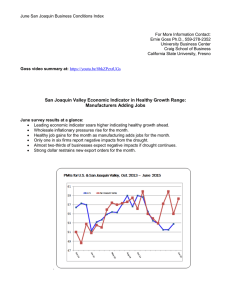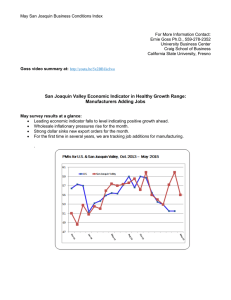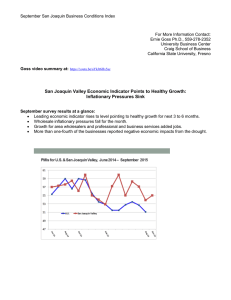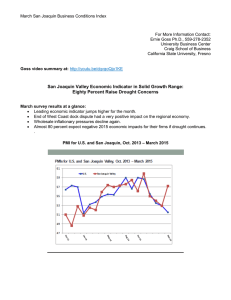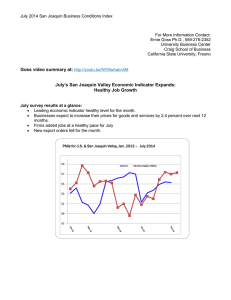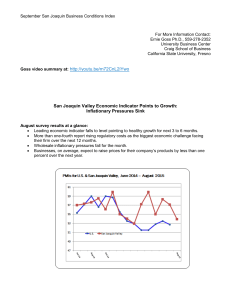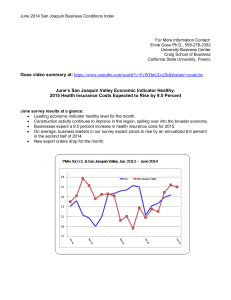Document 13092158
advertisement
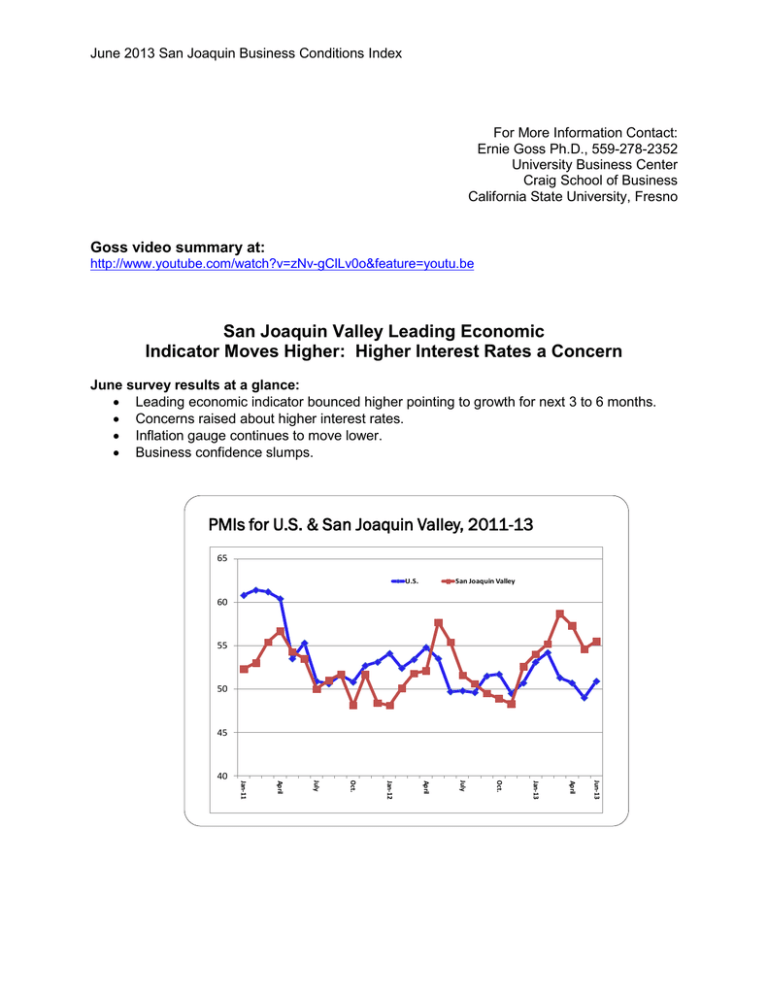
June 2013 San Joaquin Business Conditions Index For More Information Contact: Ernie Goss Ph.D., 559-278-2352 University Business Center Craig School of Business California State University, Fresno Goss video summary at: http://www.youtube.com/watch?v=zNv-gClLv0o&feature=youtu.be San Joaquin Valley Leading Economic Indicator Moves Higher: Higher Interest Rates a Concern June survey results at a glance: Leading economic indicator bounced higher pointing to growth for next 3 to 6 months. Concerns raised about higher interest rates. Inflation gauge continues to move lower. Business confidence slumps. PMIs for U.S. & San Joaquin Valley, 2011-13 65 U.S. San Joaquin Valley 60 55 50 45 Jun-13 April Jan-13 Oct. July April Jan-12 Oct. July April Jan-11 40 San Joaquin Business Conditions Index – p. 2 of 3 For Immediate Release: July 1, 2013 FRESNO, CA-After declining for two straight months, the San Joaquin Valley Business Conditions Index expanded, pointing to growth in the next 3 to 6 months. The index is a leading economic indicator from a survey of individuals making company purchasing decisions in firms in the counties of Fresno, Madera, Kings and Tulare. The index is produced using the same methodology as that of the national Institute for Supply Management (www.ism.ws). Overall Index: The index climbed to 55.5 from May’s 54.6. An index greater than 50 indicates an expansionary economy over the course of the next three to six months. Survey results for the last two months and one year ago are listed in the accompanying table. “More than one-third, or 35.7 percent, reported that very low interest rates were the most important factor pushing growth higher. While rates have risen over the past month, I expect interest rates to stabilize at their current levels supporting positive but somewhat slower growth for the area in the months ahead. Wholesalers and construction firms will continue to add jobs,” said Ernie Goss, Ph.D., research faculty with the Craig School of Business at California State University, Fresno. Employment: For an eighth straight month, the hiring gauge moved above the growth neutral threshold. The job index rose to 58.4 from 55.7 in May. Readings over the past several months indicate that the job market has been expanding and will continue to improve. “Over the past year the metropolitan area has added jobs at a pace almost double that of the U.S. As a result, the area’s unemployment rate has declined by almost 2.5 percentage points. Based on surveys over the past several months, job growth will continue for the area but at a somewhat slower pace with higher interest rates and slower global growth creating a slight economic headwind,” said Goss. Wholesale Prices: The prices-paid index, which tracks the cost of raw materials and supplies, decreased from 62.0 in May to June’s 58.8. “Wholesale inflationary pressures continue to move lower in the region. A 5 percent increase in the value of the U.S. dollar in 2013 and slower global economic growth have placed downward pressure on inflation at the wholesale level. Not only is wholesale inflation low, it is headed lower. Lower inflation and San Joaquin Business Conditions Index – p. 3 of 3 slower growth will insure that the Federal Reserve does not alter its bond buying program any time soon,” said Goss. Business Confidence: Looking ahead six months, economic optimism, captured by the business confidence index, dipped to 50.8 from May’s 51.6. “Higher interest rates and slower global economic growth pushed the economic outlook lower for the month,” said Goss. Inventories: Businesses reduced inventories for the month. The index increased to a still weak 46.8 from 46.3 in May. A pullback in inventory levels is another signal of a downturn in the economic outlook as businesses anticipate slower growth in the months ahead. Trade: The new export order reading slumped to 49.9 from May’s much stronger 59.9. At the same time, June’s import reading moved higher with a June reading of 56.6, up from May’s 50.8 and April’s 51.5. “Two factors are weighing against exports. The U.S. dollar has expanded by five percent in 2013. This has made U.S. goods less competitively priced abroad. Likewise, slower global growth has reduced demand for U.S. and area products abroad,” said Goss. Other components: Other components of the June Business Conditions Index were new orders at 56.6, up slightly from 55.3 in May; production or sales at 58.7, down from last month’s 59.1; and delivery lead time at 57.1, up from 56.4 in May. Table 1 details survey results for June 2012, last month, and June 2013. June survey results will be released on the first business day of next month, August 1. Table 1: Overall and component indices for last 2 months and one year ago (above 50.0 indicates expansion) San Joaquin Valley June 2012 May 2013 June 2013 Leading economic indicator 55.4 54.6 55.5 New orders 51.8 55.3 56.6 Production or sales 52.3 59.1 58.7 Employment 55.0 55.7 58.4 Inventories 60.4 46.3 46.8 Delivery lead time 57.6 56.4 57.1 Wholesale prices 50.5 62.0 58.8 Imports 54.4 50.8 56.6 Export orders 67.7 59.9 49.9 Business confidence 49.5 51.6 50.8 Craig School of Business: http://www.craig.csufresno.edu/ Follow Goss: Twitter at http://twitter.com/erniegoss or www.ernestgoss.com
